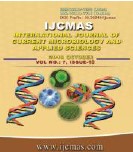


 National Academy of Agricultural Sciences (NAAS)
National Academy of Agricultural Sciences (NAAS)

|
PRINT ISSN : 2319-7692
Online ISSN : 2319-7706 Issues : 12 per year Publisher : Excellent Publishers Email : editorijcmas@gmail.com / submit@ijcmas.com Editor-in-chief: Dr.M.Prakash Index Copernicus ICV 2018: 95.39 NAAS RATING 2020: 5.38 |
Starches from the wheat (UP262, PBW343), rice (PB2, PD19) and millets (Finger millet VL Mandua-352, Barnyard millet VL Madira-207, Foxtail millet DHFT-109-3) were isolated by alkali extraction method and characterized for morphologically and biochemical properties. The morphological properties of starch granules were studied by scanning electron microscope. The infrared spectroscopy is sensitive to structural changes on starch macromolecule, such as helicoidal chain conformation, crystallinity, retrogradation and water content. Starch yield was found maximum in rice followed by wheat and millets. High value of amylose-amylopectin ratio indicates low glycemic index. Amylose content is important for food processing in the industry and for quality. The amylose content (%) was found significant in all cultivars. The amylose content (%) was found maximum in rice (PB2, PD19) and wheat (UP262) followed by PBW343 (Wheat) and finger millet. The amylose content in millet varies from 31-33%. Total starch content ranged from 57-70% in cereals in the present study. Total starch content was found maximum in rice followed by wheat and millets. Total starch content in rice (PB2 & PD19) was found 67% and 70% respectively. The proximate content of total starch in barnyard millet (58%), finger millet (57%) and foxtail millet (59%) was found in the present study. Scanning electron microscopy (SEM) has been a useful tool for investigating the microstructures of cereal grains and derived products.
 |
 |
 |
 |
 |